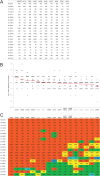Identification of amino acid substitutions supporting antigenic change of influenza A(H1N1)pdm09 viruses
- PMID: 25609810
- PMCID: PMC4403388
- DOI: 10.1128/JVI.02962-14
Identification of amino acid substitutions supporting antigenic change of influenza A(H1N1)pdm09 viruses
Abstract
The majority of currently circulating influenza A(H1N1) viruses are antigenically similar to the virus that caused the 2009 influenza pandemic. However, antigenic variants are expected to emerge as population immunity increases. Amino acid substitutions in the hemagglutinin protein can result in escape from neutralizing antibodies, affect viral fitness, and change receptor preference. In this study, we constructed mutants with substitutions in the hemagglutinin of A/Netherlands/602/09 in an attenuated backbone to explore amino acid changes that may contribute to emergence of antigenic variants in the human population. Our analysis revealed that single substitutions affecting the loop that consists of amino acid positions 151 to 159 located adjacent to the receptor binding site caused escape from ferret and human antibodies elicited after primary A(H1N1)pdm09 virus infection. The majority of these substitutions resulted in similar or increased replication efficiency in vitro compared to that of the virus carrying the wild-type hemagglutinin and did not result in a change of receptor preference. However, none of the substitutions was sufficient for escape from the antibodies in sera from individuals that experienced both seasonal and pandemic A(H1N1) virus infections. These results suggest that antibodies directed against epitopes on seasonal A(H1N1) viruses contribute to neutralization of A(H1N1)pdm09 antigenic variants, thereby limiting the number of possible substitutions that could lead to escape from population immunity.
Importance: Influenza A viruses can cause significant morbidity and mortality in humans. Amino acid substitutions in the hemagglutinin protein can result in escape from antibody-mediated neutralization. This allows the virus to reinfect individuals that have acquired immunity to previously circulating strains through infection or vaccination. To date, the vast majority of A(H1N1)pdm09 strains remain antigenically similar to the virus that caused the 2009 influenza pandemic. However, antigenic variants are expected to emerge as a result of increasing population immunity. We show that single amino acid substitutions near the receptor binding site were sufficient to escape from antibodies specific for A(H1N1)pdm09 viruses but not from antibodies elicited in response to infections with seasonal A(H1N1) and A(H1N1)pdm09 viruses. This study identified substitutions in A(H1N1)pdm09 viruses that support escape from population immunity but also suggested that the number of potential escape variants is limited by previous exposure to seasonal A(H1N1) viruses.
Copyright © 2015, American Society for Microbiology. All Rights Reserved.
Figures






References
-
- World Health Organization. February 2014. Recommended composition of influenza virus vaccines for use in the 2014-2015 northern hemisphere influenza season. World Health Organization, Geneva, Switzerland: http://www.who.int/influenza/vaccines/virus/recommendations/201402_recom.... - PubMed
-
- Virelizier JL. 1975. Host defenses against influenza virus: the role of anti-hemagglutinin antibody. J Immunol 115:434–439. - PubMed
Publication types
MeSH terms
Substances
Grants and funding
LinkOut - more resources
Full Text Sources

